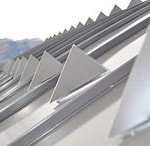Snow Clips and Metal Roofs are usually present on any new construction. Ice and snow building up on rooftops can be a serious problem, and owners of homes or buildings with certain slick roofing materials look to snow clips to solve the problem. So, what are snow clips and where are they installed? They’re small triangular peaks typically made of plastic or metal and fastened to metallic or other slick rooftops near the eave to break down snow and ice that has accumulated so that it won’t all fall at once in a heavy clump or sheets of ice which can injure people and tear off gutter systems.
Snow clips aren’t perfect for all roofs. There are negative and positive results when installing snow bars, clips or rails. What kinds of roofs surfaces actually benefit the most from snow clip, snow bars or railing installation? Can these different products actually reduce hazards present when heavy snow and ice build up on roofs? Is installing clips expensive or can it be done by the homeowner with relative ease? The answers to these questions can give the average home owner help in making an informed decision.
Metal roofs are the ideal candidate for installing snow clips, snow railing or bar systems. If your home has an existing metal roof, you know how often ice and snow slide right off over the eaves onto ground below, and you know why snow clips and other systems came into being. But not all metallic roofs need clips. Snow retention devices such as clips are worthless on a flat rooftop where manual snow removal is the only option. Snow does not fall from flat roofs either. Sloped roofs made of all different types of materials can benefit from having some type of snow retention device installed. Heavily pitched tile, slate, or metal rooftops in areas that typically have at least one decent snowfall each winter can benefit the most from installing these snow retention devices and prevent possible injury to occupants.
While adding these devices is probably never a bad idea, not all regions encounter enough snow and ice buildup to warrant the expense of installing snow clip systems. Heavy snow load climates obviously call for snow retention devices. However, the danger of falling ice and snow can be very hazardous. Injuries and even some deaths occur every winter, and vehicles and other property are severely damaged each year by sudden falls of masses of snow and ice from rooftops. While manual snow removal by owners or by hired help can replace these devices, the dangers of actually being on the rooftop in winter conditions is removed.
Installation can present some difficulties. While snow clips can be installed without professional assistance, it may be a difficult task for those who aren’t familiar with working on slippery rooftops. Hiring a roofing contractor or other assistance may be expensive and beyond the means of some home owners. Clips can typically only be installed in warmer months, as cold temperatures can render adhesives and sealants ineffective. However, for any able-bodied handyman , this may be a pretty straightforward installation project that could make a building or household safer in the winter.
The Barrie Home Inspector regularly checks metal roofs for signs of gutter damage and other deficiencies caused by falling ice and snow.

